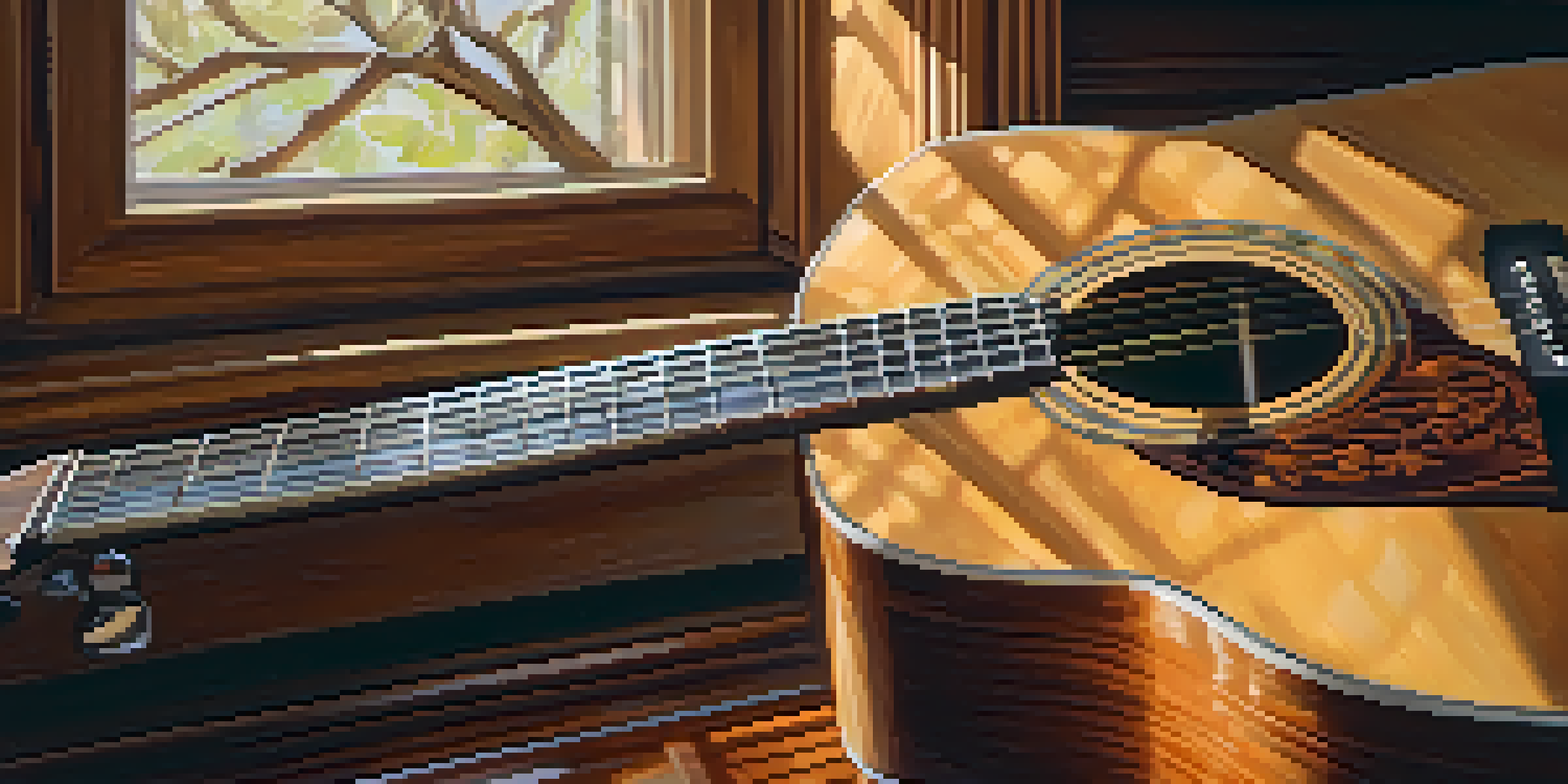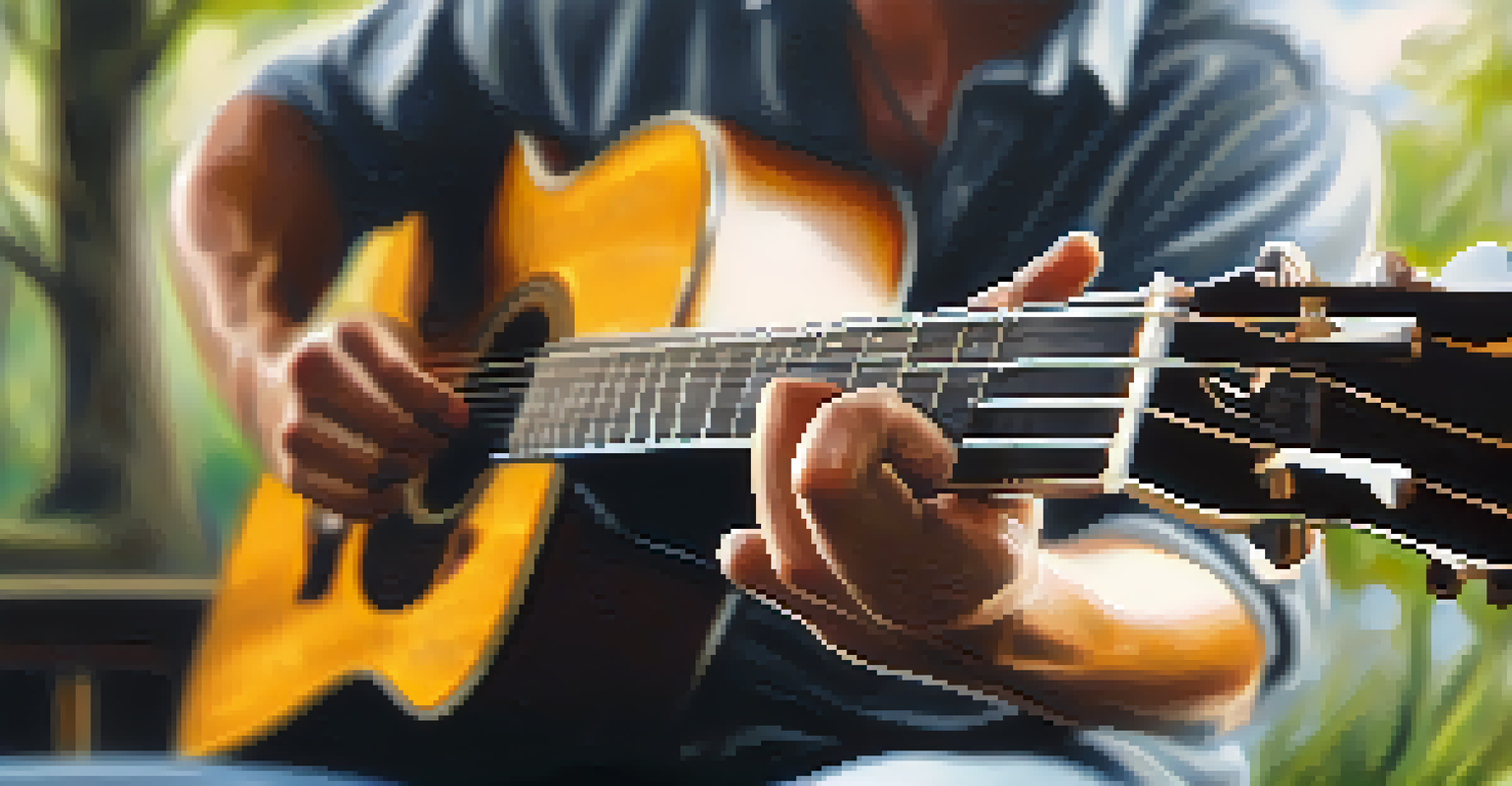Exploring Acoustic Guitar Styles and Techniques for Beginners

Understanding the Basics of Acoustic Guitar
Before diving into different styles, it's crucial to grasp the basics of the acoustic guitar. Familiarize yourself with the parts of the guitar, such as the body, neck, and strings, as each plays a vital role in sound production. Knowing how to hold the guitar properly and tune it is also essential for beginners, setting the foundation for your journey.
The guitar is a miniature orchestra in itself.
Once you're comfortable with the basics, start practicing simple chords. Chords are the building blocks of most songs and will help you understand how different notes work together. It’s helpful to start with open chords like G, C, and D, which are commonly used in many popular songs.
As you progress, you'll notice how these basics apply to various styles of playing. The foundation you've built will allow you to explore the nuances of fingerpicking, strumming patterns, and more advanced techniques that define different acoustic genres.
Exploring Fingerstyle Guitar Techniques
Fingerstyle guitar is a captivating technique where you pluck the strings with your fingers instead of using a pick. This style allows for intricate melodies and harmonies, making it popular in folk, classical, and blues music. To start, practice using your thumb for the bass notes and your fingers for the higher strings.

One effective way to develop your fingerstyle technique is to learn simple fingerpicking patterns. Begin with a basic pattern like alternating bass notes with melody notes, which can create a rich, layered sound. This approach not only strengthens your fingers but also enhances your musicality.
Master the Basics of Guitar
Understanding the fundamental parts and techniques of the acoustic guitar lays the groundwork for your musical journey.
As you become more comfortable, try learning popular fingerstyle songs. Artists like Tommy Emmanuel and Andy McKee offer great examples of how beautiful fingerstyle can be. By playing along, you’ll not only improve your skills but also gain insight into the expressive potential of this technique.
Strumming Patterns: The Heartbeat of Acoustic Music
Strumming is a fundamental technique that gives life to your acoustic guitar playing. Different strumming patterns can evoke various emotions and styles, from upbeat folk tunes to soothing ballads. Start with simple downstrokes and gradually add upstrokes to create a more dynamic sound.
Music is the shorthand of emotion.
One way to practice strumming is to play along with your favorite songs. Listen closely to the rhythm and try to mimic the strumming pattern. This not only reinforces your timing but also helps you understand how strumming patterns complement melodies.
As you improve, experiment with different strumming patterns and incorporate them into your playing. Don't be afraid to mix things up; this is where you can start to develop your unique sound and style on the acoustic guitar.
Diving into Open Tunings for Unique Sounds
Open tunings can bring a fresh perspective to your acoustic guitar playing. By tuning your guitar to a specific chord, you can create unique sounds and make it easier to play certain styles, especially slide guitar. Common open tunings include Open D and Open G, both of which are popular in folk and blues music.
To explore open tunings, start by learning how to tune your guitar correctly. It might feel odd at first, but the new chord shapes will inspire creativity and offer new songwriting possibilities. Playing in open tunings can also enhance your improvisation skills, allowing you to discover unexpected melodies and harmonies.
Explore Unique Playing Techniques
Incorporating fingerstyle, open tunings, and percussive techniques can significantly enhance your acoustic guitar playing.
Once you're comfortable with a few open tunings, start experimenting with different songs. Try playing familiar tunes in an open tuning to experience a new flavor in your music. This exploration can be incredibly rewarding and might just lead you to new musical avenues.
The Role of Capos in Acoustic Guitar Playing
A capo is a simple yet powerful tool that can expand your acoustic guitar playing. By placing a capo on the fretboard, you can change the key of your guitar without having to learn new chord shapes. This is particularly useful for playing along with singers or other musicians who prefer different keys.
Using a capo can also help you explore various voicings of familiar chords. For instance, moving a capo to the second fret while playing an open G chord gives you an A chord sound, adding a fresh twist to your playing. This versatility is a favorite among songwriters and performers alike.
When using a capo, try to experiment with different placements and see how it affects the sound of your guitar. You might discover new melodies or arrangements that inspire your creativity. A capo can truly be a game-changer in your acoustic guitar journey.
Incorporating Percussive Techniques into Your Playing
Percussive techniques add an exciting layer to your acoustic guitar performance. By tapping or slapping the body of the guitar, you can create rhythm and enhance the overall sound. This technique is often used in styles like percussive fingerstyle and contemporary acoustic music.
To start incorporating percussion into your playing, try simple taps on the guitar body while strumming or fingerpicking. This can create a beat that complements your playing without overwhelming the melody. It's a great way to engage your audience and add a dynamic element to your performance.
Practice with Patience and Joy
Consistent practice, setting achievable goals, and enjoying the learning process are key to becoming a skilled guitarist.
As you become more comfortable with percussive techniques, aim to combine them with different strumming or fingerpicking patterns. This can lead to unique arrangements and inspire you to push the boundaries of traditional acoustic guitar playing.
The Importance of Practice and Patience
Learning acoustic guitar is a journey that requires consistent practice and patience. It's normal to feel overwhelmed at first, but remember that every great guitarist started where you are now. Establishing a regular practice routine can help you build confidence and improve your skills over time.
Set achievable goals for yourself, whether it's mastering a specific song or technique. Breaking down your practice into manageable chunks can make the process feel less daunting. Celebrate small victories along the way; they can motivate you to keep going.

Lastly, don't forget to enjoy the journey. Playing the acoustic guitar should be a fun and rewarding experience. Embrace the learning process, and soon enough, you'll find yourself exploring new styles and techniques with ease.